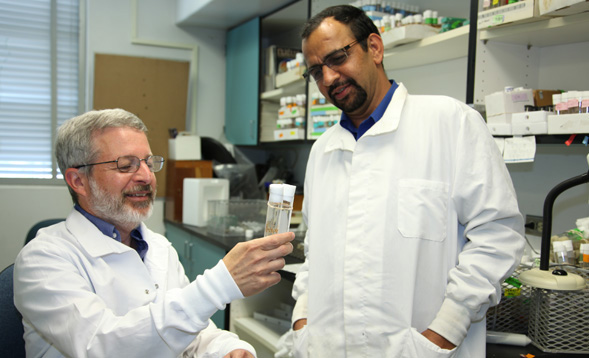A Muscular Legacy
SDSU biologist Sanford Bernstein was given a prestigious award honoring his longtime research into muscle proteins.

Bernstein studies myosin, a motor protein involved in muscle contraction, in fruit flies. These model organisms reproduce quickly, their genetics are well studied, and their basic musculature operates similarly to human muscles. Studying them allows Bernstein to learn more about how variations of the myosin protein can help or hinder muscle function in normal and diseased skeletal muscle and heart muscle.
Bernstein came to SDSU in 1983 and immediately received a research grant from the NIH to explore myosin in fly muscles. His research at SDSU has been primarily funded from the same NIH R01 grant—the federal agency’s principal funding mechanism—ever since, having been renewed eight times for 4- or 5-year cycles.
The MERIT Award recognizes research that has received outstanding scores from the NIH’s grant reviewers for four consecutive grant cycles, in addition to the researcher’s record of scientific accomplishment and academic service.
The NIH National Institute of General Medical Sciences typically awards four-year R01 grants to senior investigators. The MERIT recognition effectively extends Bernstein’s existing R01 grant for at least one more year, with the potential for it to be renewed up to five additional years beyond that. If funded to its full potential, the award could be worth more than $5 million in research funding.
“Competition for NIH awards is really tough because there’s so much scrutiny to make sure the best science is being funded,” said Stanley Maloy, dean of SDSU’s College of Sciences. “When you get a MERIT Award, it means they’re extremely confident in the impact and continuity of your work. It’s an amazing compliment and reflects Dr. Bernstein’s accomplishments.”
Pushing the envelope
Scientists who receive a MERIT Award are encouraged to explore new avenues of their research that might otherwise be considered too risky or preliminary to submit for a grant proposal.“The basic idea behind the MERIT Award is that it’s supposed to give you, as a researcher, some flexibility in the direction of your work,” Bernstein said.
As he enters the Faculty Early Retirement Program, which allows faculty members to officially retire while still teaching and maintaining an active research program on campus, Bernstein plans to turn some of his lab’s attention to the effects of myosin on aging.
“I figured that as I approach retirement, it would be appropriate to look at aging,” he said.
In that vein, he will investigate whether certain age-related modifications to the myosin protein exacerbate the aging process in his fly muscle model, as well as looking at how mutant versions of myosin that are associated with heart disease during human aging play out when transplanted into fly hearts. He will be collaborating with two of his former post-doctoral fellows: Douglas Swank, an associate professor at Rensselaer Polytechnic Institute, and Anthony Cammarato, an assistant professor at the Johns Hopkins University School of Medicine. He will also be working with SDSU biochemist Tom Huxford to pin down the atomic-level structure of myosin mutations for the first time.
“Learning more about the structure of myosin could potentially lead to new molecular therapies to treat muscle and heart disease and age-related degeneration,” Bernstein said.



